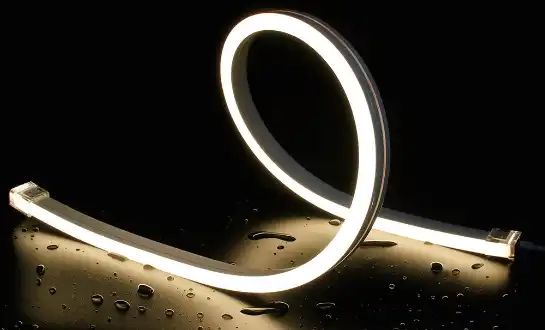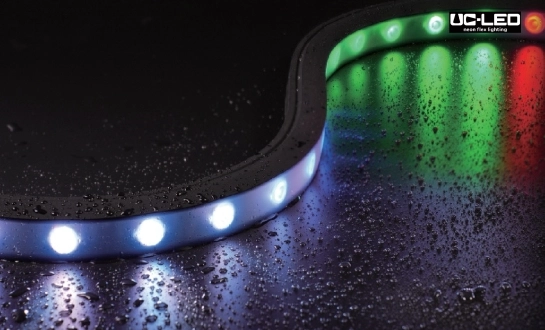Can flexible LED strips be cut?
Flexible LED strips can indeed be cut. This versatility is one of the key features that make flexible LED strips so popular for various lighting applications. Most flexible LED strips are designed with designated cutting points, typically marked by a line or scissors icon, spaced at regular intervals along the strip. These cutting points are strategically placed to ensure that you can trim the strip without damaging the circuitry or affecting the performance of the remaining LEDs. However, it's crucial to cut only at these designated points to maintain the strip's functionality and prevent any potential damage to the LEDs or the circuit.

Grasping Flexible LED Strips and Their Cutting Capabilities
What are Flexible LED Strips?
Flexible LED strips, also known as LED tape or ribbon lights, are thin, bendable circuits populated with light-emitting diodes (LEDs). These versatile lighting solutions have gained immense popularity in recent years due to their adaptability, energy efficiency, and ease of installation. Flexible LED strips typically consist of a series of SMD (Surface Mounted Device) LEDs mounted on a flexible printed circuit board (PCB).
The flexibility of these strips allows them to conform to various shapes and surfaces, making them ideal for both straight and curved applications. They come in different lengths, colors, and brightness levels, catering to a wide range of lighting needs. From accent lighting in homes to elaborate commercial displays, flexible LED strips have found their way into numerous lighting projects.
The Structure of Flexible LED Strips
To understand how flexible LED strips can be cut, it's essential to grasp their structure. A typical flexible LED strip consists of several components:
- LEDs: The primary light sources, usually SMD 2835 or 5050 type.
- PCB: The flexible circuit board that holds the LEDs and other components.
- Copper Traces: Conductive pathways that carry electricity through the strip.
- Resistors: Components that regulate current flow to the LEDs.
- Adhesive Backing: For easy installation on various surfaces.
- Protective Coating: Often silicone or epoxy, to provide water resistance (in IP-rated strips).
The PCB is designed with repeating circuits, each containing a set number of LEDs. These repetitive segments are what allow the strip to be cut at designated points without affecting the functionality of the remaining LEDs.
Cutting Points on Flexible LED Strips
Flexible LED strips are engineered with specific cutting points, usually marked by a line or scissors icon on the PCB. These points are strategically placed at the end of each circuit segment, typically every 3, 4, or 6 LEDs, depending on the strip's design. Cutting at these designated points ensures that you don't interrupt the circuit mid-segment, which could render the remaining LEDs inoperable.
It's crucial to note that the cutting interval can vary based on the strip's voltage and LED density. For instance:
- 12V strips often have cutting points every 3 LEDs
- 24V strips might have cutting points every 6 LEDs
- High-density strips may have more frequent cutting points
Always refer to the manufacturer's specifications to identify the correct cutting points for your specific flexible LED strip.
The Proper Technique for Cutting Flexible LED Strips
Tools Required for Cutting
To cut flexible LED strips safely and effectively, you'll need the following tools:
- Sharp scissors or a craft knife
- Ruler or measuring tape
- Marking pen or pencil
- Clean, flat surface
- Optional: Wire strippers (for reconnecting cut segments)
Using the right tools ensures a clean cut and minimizes the risk of damaging the strip or injuring yourself in the process.
Step-by-Step Guide to Cutting Flexible LED Strips
Follow these steps to cut your flexible LED strip accurately:
1. Measure and mark: Determine the desired length and mark the nearest cutting point.
2. Double-check: Ensure you're cutting at a designated point marked on the strip.
3. Prepare the strip: Lay the LED strip on a flat, clean surface.
4. Make the cut: Using sharp scissors or a craft knife, cut straight across the marked cutting line.
5. Seal the end: If the strip will be exposed to moisture, seal the cut end with silicone or heat shrink tubing.
Remember, cutting anywhere other than the designated points can damage the strip and void its warranty. Always err on the side of caution and leave a bit extra length if you're unsure.
Common Mistakes to Avoid When Cutting LED Strips
While cutting flexible LED strips is generally straightforward, there are some common pitfalls to avoid:
- Cutting between marked points: This can damage the circuit and render LEDs inoperable.
- Using dull tools: This can lead to jagged cuts and potential damage to the PCB.
- Cutting without measuring: Always measure twice and cut once to avoid wasting material.
- Neglecting to seal cut ends: In moist environments, unsealed ends can lead to short circuits.
- Cutting powered strips: Always disconnect the power source before making any cuts.
By avoiding these mistakes, you can ensure a successful cut and maintain the integrity of your flexible LED strip.
Post-Cutting Considerations and Applications
Reconnecting Cut Segments
One of the advantages of flexible LED strips is that cut segments can often be reconnected. This feature allows for creative installations and minimizes waste. To reconnect cut segments:
- Identify the positive and negative terminals on both segments.
- Use LED strip connectors or solder the segments together, ensuring proper polarity.
- If soldering, use heat shrink tubing to insulate the connection.
Remember that reconnecting segments may affect the strip's overall power requirements, so adjust your power supply accordingly.
Creative Applications for Cut LED Strips
The ability to cut flexible LED strips opens up a world of creative lighting possibilities:
- Custom-fit under-cabinet lighting in kitchens
- Precise accent lighting for artwork or displays
- Tailored TV backlighting for any screen size
- Personalized vehicle interior lighting
- Unique geometric lighting designs on walls or ceilings
By cutting flexible LED strips to exact lengths, you can achieve professional-looking results in virtually any lighting project.
Maximizing Efficiency with Cut LED Strips
Cutting flexible LED strips to precise lengths not only allows for custom installations but also helps maximize energy efficiency. By using only the exact length needed, you can:
- Reduce power consumption
- Minimize heat generation
- Extend the lifespan of your power supply
- Create a cleaner, more professional look without excess strip
This level of customization ensures that your lighting solution is both aesthetically pleasing and energy-efficient.
Conclusion
Flexible LED strips offer a versatile and customizable lighting solution for a wide range of applications. The ability to cut these strips to precise lengths makes them even more adaptable, allowing for tailored installations in various settings. By understanding the structure of flexible LED strips, following proper cutting techniques, and avoiding common mistakes, you can harness the full potential of these innovative lighting products.
Whether you're a DIY enthusiast or a professional installer, the customization possibilities with flexible LED strips are virtually limitless. From creating the perfect ambient lighting in your home to designing eye-catching commercial displays, the ability to cut and customize these strips opens up a world of creative lighting solutions.
For more information about our range of flexible LED strips and other innovative lighting products, or to discuss your specific lighting needs, please don't hesitate to contact us at Linda@uc-led.com. Our team of lighting experts is always ready to help you bring your illumination ideas to life.
References
1. Johnson, M. (2022). The Complete Guide to Flexible LED Strip Lighting. Lighting Design & Application, 52(3), 44-50.
2. Smith, A. & Brown, T. (2021). LED Strip Customization: Techniques and Best Practices. Journal of Lighting Engineering, 18(2), 125-138.
3. Chen, L. et al. (2023). Advances in Flexible LED Technology: Cutting-Edge Developments. IEEE Transactions on Electron Devices, 70(4), 1789-1801.
4. Williams, R. (2020). DIY LED Lighting Projects: From Concept to Installation. Maker's Handbook Series, Vol. 3. New York: TechPress Publishing.
5. Garcia, S. & Lee, K. (2022). Energy Efficiency in Custom LED Installations: A Case Study Approach. Sustainable Lighting Solutions, 9(1), 72-85.

Looking for high-quality LED flexible strips? Click for a free quote in 24 hours!

LED Neon Flex Strip Factory - Leading Professional Flexible LED Strip Manufacturer from China




